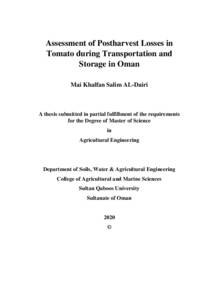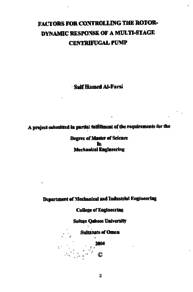Document
Assessment of postharvest losses in tomato during transportation and storage in Oman.
Identifier
Al-Dairiyah, Mai Khalfan Salim (2020). Assessment of postharvest losses in tomato during transportation and storage in Oman (Master thesis, Sultan Qaboos University, Muscat, Oman).
Publisher
Sultan Qaboos University.
Gregorian
2020
Language
English
English abstract
One-third of all food produced globally is lost due to postharvest losses. Transportation
is particularly essential to distribute fresh produce during postharvest supply chain, but
the effect of vibration, duration and distance during transport can cause high internal
and surface damage to fresh produce. Therefore, this study aims to evaluate postharvest
losses in tomato (Solanum lycopersicum L.) during transportation in the Sultanate of
Oman and to develop a mathematical model to estimate the whole changes in tomato
quality as affected by transportation and storage. Tomato was transported from three
different distances (100 km, 154 km and 205 km) from local farm and delivered to the
laboratory to undergo physical, chemical and nutritional quality analysis. Tomato was
stored at two different temperature (10°C and 22°C) for 12 days. During transport, 3-
Axis USB Vibration/Acceleration Data Logger was used to record the data related to
vibration. Two factorial balanced analysis of variance (ANOVA) and analysis of
regression were performed using SPSS software. The results of vibration showed that
the maximum number of peaks was found mostly in the acceleration interval of 0.99-
1.17 g. Over 40% of accelerations occurred in the range of 0.82-1.31g of all transport
distances. Laboratory experiment showed that all physical quality analysis like weight
loss and firmness were highly affected by transport distance, storage temperature and
storage period. The reduction in weight loss and firmness was the highest in tomato
transported from the longest distance and stored at 22°C with 6.91% and 58.39%
respectively. Lightness, yellowness and hue values showed a high reduction as
transport distance increase particularly in tomato stored at 22°C. In addition, redness,
total color change and color indices (CI and COL) increased significantly on tomato
transported from 205 km and stored at both storage temperatures. Regarding chemical
analysis, pH, total soluble solid (TSS) and sugar:acid ratio were largely affected by
storage condition and duration but not by transporting distance. However, titratable
acidity was significantly affected by all investigated factors. Titratable acidity (TA) was
lower in tomato transported form the longest distance and stored at 22°C with 0.25%
followed by 0.26% in tomato transported from medium and short distance. Lycopene
and carotenoids were highly affected by all studied factors. The highest amount of both
lycopene and carotenoids was observed in tomato transported from long distance at
22°C on day12 with 1.21 mg.100g-1FW and 1.55 mg.100g-1FW respectively. Zeroorder and first-order models used to describe physical, chemical and nutritional quality
changes during storage. Experimental data of weight loss from all distances at both
storage conditions for 12 days was highly fitted to zero-order model. The appropriate
model used to describe total soluble solid, sugar/acid ratio, carotenoids and lycopene
was zero-order model. To reduce the amount of postharvest losses during transport,
temperature and other appropriate facilities during and after transportation need to be
managed.
Member of
Resource URL
Arabic abstract
يتم فقد ثلث الاغذية المنتجة عالمًيا بسبب خسائر ما بعد الحصاد. النقل مهم للغاية لتوزيع المنتجات الطازجة أثناء سلسلة التوريد بعد الحصاد ، ولكن تأثير الاهتزاز والمدة والمسافة أثناء النقل يمكن أن يسبب تلفًا داخليًا وسط ًحيا كبي ًرا للمنتجات الطازجة. لذلك ، تهدف هذه الدراسة إلى تقييم خسائر ما بعد الحصاد في الطماطم أثناء النقل في سلطنة عمان ، وتطوير نموذج رياضي لتقدير جميع التغيرات في الطماطم حسب تأثرها بالنقل والتخزين. تم نقل الطماطم من ثالث مسافات مختلفة )100 كم ، 154 كم و 205 كم( من المزرعة وتم تسليمها إلى المختبر للخضوع لتحليل الجودة الفيزيائية والكيميائية والتغذوية. تم تخزين الطماطم في درجتي حرارة مختلفتين )10 درجة مئوية و 22 درجة مئوية( لمدة 12 يو ًما. أثناء النقل ، تم استخدام مسجل بيانات الاهتزاز ثالثي المحاور لتسجيل البيانات المتعلقة بالاهتزاز.تم إجراء تحليلين متوازنين عاملين للتباين وتحليل الانحداربإستخدام برنامج اس بي اس اس. أظهرت نتائج الاهتزاز ان الحد الاقصى لعدد القمم قد تم العثور عليها في فترة التسارع من 99.0-17.1 في جميع مسافات النقل. أكثر من 80 %من التسارع حدث في نطاق 82.0-31.1 لجميع مسافات النقل. أظهرت التجربة المختبرية أن جميع تحليالت الجودة الفيزيائية مثل فقدان الوزن والصالبة تأثرها بشدة بمسافة النقل ودرجة حرارة التخزين وفترة التخزين. كان الانخفاض في فقدان الوزن والصالبة هو الاعلى في الطماطم المنقولة من أطول مسافة والتي تم تخزينها عند 22 درجة مئوية بنسبة 91.6 ٪و 39.58 ٪على التوالي. أظهرت قيم الخفة والصفرة والصبغة انخفا ًضا كبي ًرا مع زيادة مسافة النقل خاصة في الطماطم المخزنة عند 22 درجة مئوية. بالاضافة إلى ذلك ، زاد الاحمرار وتغير اللون الكلي ومؤشرات الالوان بشكل ملحوظ على الطماطم المنقولة من 205 كم والمخزنة في كل من ظروف التخزين. فيما يتعلق بالتحليل الكيميائي ، تأثرالرقم الهيدروجيني والصلبة و مجموعة المواد الصلبة القابلة للذوبان و نسبة الحمض/السكر بشكل كبير بحالة التخزين ومدته ولكن ليس بمسافة النقل. ومع ذلك ، تأثرت حموضة المعايرة بشكل كبير بجميع العوامل التي تم بحثها. كانت الحموضة القابلة للمعايرة أقل في الطماطم المنقولة من أطول مسافة وتم تخزينها عند 22 درجة مئوية مع 25.0 ٪متبو ًعا بنسبة 26.0 ٪في الطماطم المنقولة من مسافة متوسطة وقصيرة. تأثر الاليكوبين والكاروتينات بشدة بجميع العوامل المدروسة. ولوحظت أعلى كمية من الاليكوبين والكاروتينات في الطماطم المنقولة من مسافة طويلة عند 22 درجة مئوية في اليوم 12 مع 21.1 مجم و 55.1 مجم على التوالي. تُستخدم نماذج من الدرجة الصفريه ومن الدرجة الاولى لوصف التغيرات الفيزيائية والكيميائية والتغذوية أثناء التخزين. تم تجهيز البيانات التجريبية لفقدان الوزن من جميع المسافات في كل من ظروف التخزين لمدة 12 يو ًما إلى حد كبير بنموذج الطلب الصفري. النموذج المناسب المستخدم لوصف إجمالي المواد الصلبة القابلة للذوبان ، ونسبة السكر / الحمض ، والكاروتينات والاليكوبين هو نموذج الترتيب الصفري . لتقليل كمية خسائر ما بعد الحصاد أثناء النقل ، يجب مراعاة إدارة درجة الحرارة ووحدات التعبئة المناسبة.
Category
Theses and Dissertations


